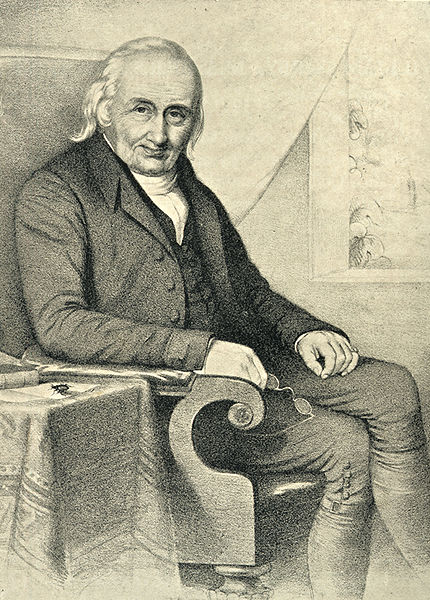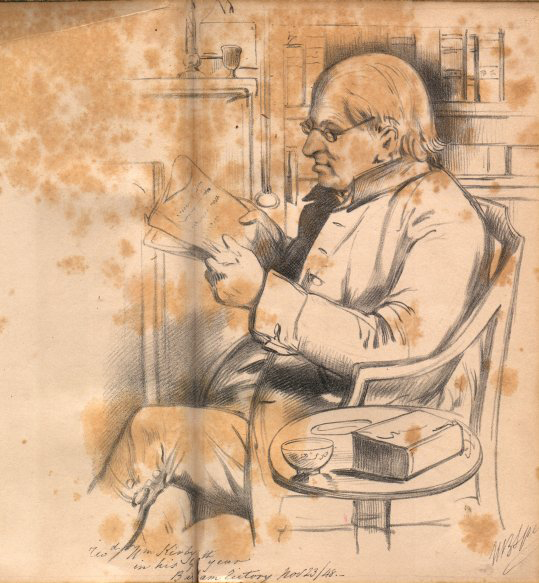<Back to Index>
- Entomologist William Kirby, 1759
- Writer Mika Toimi Waltari, 1908
- King of France Henry III, 1551
PAGE SPONSOR


William Kirby (19 September 1759 – 4 July 1850) was an English entomologist, an original member of the Linnean Society and a Fellow of the Royal Society. He is considered the "founder of entomology".
Kirby was a grandson of the Suffolk topographer John Kirby (author of The Suffolk Traveller) and nephew of artist - topographer Joshua Kirby (a friend of Thomas Gainsborough's). He was also a cousin of the children's author Mrs Sarah Trimmer. His parents were William Kirby, a solicitor, and Lucy Meadows. He was born at Witnesham, Suffolk, and studied at Ipswich School and Caius College, Cambridge, where he graduated in 1781. Taking holy orders in 1782, he spent his entire life in the peaceful seclusion of an English country parsonage at Barham in Suffolk. He assisted in the publication of pamphlets against Thomas Paine during the 1790s.
Kirby was brought to the study of natural history by Dr Nicholas Gwynn (a friend of Boerhaave's), who introduced him to Dr Smith (Sir James Edward Smith) at Ipswich in 1791. Soon afterwards he corresponded with Smith seeking advice in the foundation of a natural history museum at Ipswich. Among his early friends were the naturalists Charles Sutton and Thomas Marsham, with whom he made lengthy scientific excursions, as later with William Jackson Hooker and others. His
name appears on the original list of Fellows of the Linnean Society. He
delivered the first of his many papers on 7 May 1793, on Three New Species of Hirudo (Linn. Trans. II, 316). Kirby produced his first major work, the Monographia Apum Angliae (Monograph on the Bees of England), in 1802. His purpose was both scientific and religious: ‘The author of Scripture is also the author of Nature:
and this visible world, by types indeed, and by symbols, declares the
same truths as the Bible does by words. To make the naturalist a
religious man – to turn his attention to the glory of God, that he may
declare his works, and in the study of his creatures may see the
loving - kindness of the Lord – may this in some measure be the fruit of
my work…’ This,
the first scientific treatise on English bees, brought him to the
notice of leading entomologists in Britain and abroad. Extensive
correspondence followed with scientists including Alexander MacLeay,
Walkenaer, Johan Christian Fabricius and Adam Afzelius. Kirby began planning his Introduction to Entomology, a celebrated title, in 1808. This was the practical result of a friendship formed in 1805 with William Spence, of Hull,
and appeared in four volumes between 1815 and 1826. Much of the work
fell to Kirby owing to Spence's ill health. The book was illustrated by John Curtis. It reached its seventh edition in 1856. In 1830 he was invited to write one of the Bridgewater Treatises, his subject being The History, Habits, and Instincts of Animals (2 vols., 1835). With Edward Sabine and J.E. Gray, Kirby prepared the natural history supplement for Captain Parry's 1819 - 1820 expedition to seek the North-West Passage: his work formed the insect section of the Account of the Animals seen by the late Northern Expedition while within the Arctic Circle 1821. His friend W.J. Hooker established his contact with Dr Richardson to involve him in the publication of findings from Sir John Franklin's 1st and 2nd expeditions, the insect section in the Fauna Boreali - Americana in 1837. In 1815 Kirby took his MA with the intention of applying for the Professorship of Botany at the University of Cambridge when
it should become vacant. A dispute arose as to whether this appointment
lay in the grant of the Senate or the Crown. Kirby's Tory political complexion proved a stumbling block, and in the event John Stevens Henslow was appointed. In 1827 Kirby assisted Mr Denny in arranging the natural history specimens at Norwich Museum.
In 1832 he helped to establish an early museum in Ipswich under the
aegis of the town's Literary Institute, and presented a herbarium and a
group of fossils. With Spence he helped to found the Entomological Society of London in 1833, with John Westwood as
Secretary, and became its Honorary President for life. On that occasion
he presented his own cabinet of insects, collected over more than forty
years, which contained many of the specimens figured in his papers. Kirby was the original President of the Ipswich Museum, 1847 - 50, fulfilling a project which he had advocated since 1791, and appeared with William Buckland and others at the opening ceremony. The attached lithograph by T.H. Maguire was
copied from the oil portrait by F.H. Bischoff commissioned for and
still displayed in the Museum. Professor Henslow succeeded him in this
office. Besides the books already mentioned he was the author of many papers in the Transactions of the Linnean Society, the Zoological Journal and other periodicals; Strictures on Sir James Smith's Hypothesis respecting the Lilies of the Field of our Saviour and the Acanthus of Virgil (1819) and Seven Sermons on our Lords Temptations (1829). His Life by the Rev. John Freeman contains an extensive list of his works.